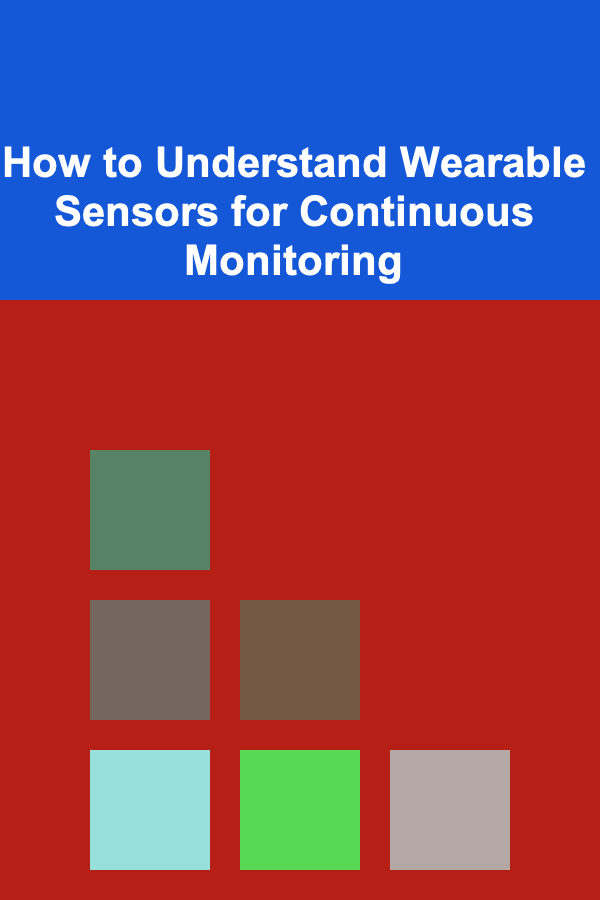
How to Understand Wearable Sensors for Continuous Monitoring
ebook include PDF & Audio bundle (Micro Guide)
$12.99$10.99
Limited Time Offer! Order within the next:

Wearable sensors have revolutionized the field of health, fitness, and personal monitoring. As technology advances, these sensors are becoming an integral part of daily life, providing continuous data collection, real-time feedback, and personalized insights. From tracking physical activity and heart rate to monitoring vital signs such as glucose levels and blood oxygen, wearable sensors are transforming healthcare and wellness.
In this article, we will explore how wearable sensors work, their applications, challenges, and the future of continuous monitoring in the context of health and wellness. By understanding these devices in-depth, users can make informed decisions about incorporating them into their routines and use them to improve their overall quality of life.
Introduction to Wearable Sensors
Wearable sensors are small, electronic devices designed to be worn on the body to collect data continuously. These sensors are often embedded in items like fitness trackers, smartwatches, clothing, and even medical devices. They capture data related to various physiological parameters such as heart rate, body temperature, movement, and even more complex metrics like glucose levels or blood pressure.
Unlike traditional monitoring systems, which often involve one-time measurements during visits to medical facilities, wearable sensors provide real-time, continuous monitoring. This continuous data flow allows for better insights, early detection of potential health issues, and the ability to track trends over time.
Types of Wearable Sensors
Wearable sensors are broadly classified into two categories:
- Physical Activity Sensors: These sensors monitor movement and activity levels. Common examples include accelerometers, gyroscopes, and magnetometers. They are often used in fitness trackers, smartwatches, and pedometers.
- Physiological Sensors: These sensors measure vital signs like heart rate, body temperature, respiration rate, and blood pressure. They are usually found in medical-grade devices and healthcare wearables.
How Wearable Sensors Work
To understand wearable sensors, it is important to know how they collect and process data. Most wearable devices contain various sensors and sensors fusion technologies that measure a range of biological and environmental signals. Here's a breakdown of how they work:
2.1. Sensors and Measurement
Accelerometers and Gyroscopes: These sensors measure movement, orientation, and acceleration. They are key components in wearable fitness trackers and smartwatches, allowing them to detect steps, activity levels, and posture. For instance, accelerometers measure changes in motion, while gyroscopes track rotation.
Photoplethysmogram (PPG) Sensors: PPG sensors are commonly used to measure heart rate and blood oxygen levels. These sensors work by emitting light through the skin and measuring the amount of light that is reflected back. Changes in blood volume affect the reflection, which can be used to monitor the pulse rate.
Electrocardiogram (ECG or EKG): Some wearable devices, especially advanced smartwatches, include ECG sensors that monitor the electrical activity of the heart. These sensors can detect arrhythmias and provide more accurate heart health data.
Temperature Sensors: Wearable temperature sensors measure the body's temperature or the skin's surface temperature. These sensors are crucial in fever detection and can be used for health monitoring, especially during illnesses like the flu or COVID-19.
Blood Pressure Monitors: Wearables with blood pressure sensors use oscillometry (the measurement of blood pressure by detecting pressure waves) to track the user's systolic and diastolic pressure levels. These sensors are often found in devices designed for chronic condition monitoring.
Electromyography (EMG): This sensor measures muscle activity and is used in advanced wearable devices that track muscle fatigue, rehabilitation, and even prosthetic control.
2.2. Data Collection and Processing
Data collected by wearable sensors is often transmitted to a smartphone, computer, or cloud-based service for processing. Raw data from the sensors is typically noisy and needs to be filtered, processed, and interpreted to provide meaningful information. Advanced algorithms are applied to process this data in real-time.
For example, an accelerometer in a fitness tracker might collect movement data and apply an algorithm to distinguish between walking, running, and resting. In healthcare devices, more complex algorithms are used to analyze the heart's rhythm, detect abnormal patterns, or monitor fluctuations in blood pressure.
2.3. Communication Technology
Most wearable sensors rely on wireless communication technologies to send the collected data to other devices. This communication is usually done through Bluetooth, Wi-Fi, or even cellular networks. Bluetooth is particularly popular in fitness and health wearables due to its low energy consumption, enabling devices to continuously send data without significant battery drain.
Applications of Wearable Sensors for Continuous Monitoring
The potential applications of wearable sensors for continuous monitoring are vast, especially in healthcare, fitness, and wellness.
3.1. Healthcare Monitoring
Wearable sensors are playing an increasingly vital role in healthcare, particularly in the management of chronic diseases, early detection of health issues, and overall patient monitoring. Some key applications include:
- Chronic Disease Management: Wearables are used to monitor conditions like diabetes, hypertension, and cardiovascular diseases. For example, continuous glucose monitors (CGMs) help diabetic patients track their blood sugar levels, while wearable blood pressure monitors can assist in managing hypertension.
- Remote Patient Monitoring (RPM): Healthcare professionals can remotely monitor patients' vital signs using wearables. This is particularly useful for patients with mobility issues or those who live in rural areas where access to healthcare is limited. RPM enables early intervention and reduces hospital visits, improving patient outcomes.
- Post-Surgery Recovery: Wearable sensors can be used to monitor patients recovering from surgeries, ensuring that they follow the prescribed physical therapy regimen and avoid potential complications.
- Real-Time Health Alerts: Wearables can alert users or healthcare providers if a significant health issue occurs. For instance, an ECG sensor might detect an irregular heartbeat, prompting an immediate alert for medical attention.
3.2. Fitness and Wellness
Wearable sensors are a powerful tool for fitness enthusiasts and people looking to improve their overall health. These devices provide continuous, real-time data about physical activity, sleep, and other wellness parameters:
- Physical Activity Tracking: Fitness trackers and smartwatches equipped with accelerometers and gyroscopes track steps, distance, calories burned, and activity levels. They can also provide feedback on users' daily goals and motivate them to stay active.
- Sleep Monitoring: Wearable devices can monitor sleep patterns, including sleep duration, quality, and stages (light, deep, and REM sleep). These insights help users improve their sleep hygiene and manage conditions like insomnia or sleep apnea.
- Stress Management: Some wearables can detect signs of stress by monitoring heart rate variability (HRV). With continuous monitoring, users can receive alerts when stress levels are high, helping them take proactive steps to manage stress.
- Athlete Performance Monitoring: Wearable sensors are used in sports to monitor an athlete's performance, track recovery, and prevent injuries. Metrics like muscle fatigue, heart rate, and sweat levels can provide insights into an athlete's training and recovery needs.
3.3. Personal Safety and Security
In addition to health and fitness, wearable sensors have applications in personal safety and security:
- Fall Detection: Many wearable devices, particularly those designed for elderly users, include fall detection sensors. If a user falls, the device can send an alert to a caregiver or family member, ensuring quick intervention.
- Emergency Alerts: Wearables with built-in GPS can send an alert with the wearer's location to emergency services in case of an emergency, such as a medical incident, accident, or personal attack.
Challenges in Wearable Sensor Technology
While wearable sensors have significant benefits, there are also several challenges that need to be addressed for them to reach their full potential:
4.1. Accuracy and Reliability
The accuracy of wearable sensors is a significant challenge, especially when measuring vital signs like heart rate, blood pressure, or blood glucose levels. Wearables rely on sensors that can be prone to inaccuracies due to user movement, environmental factors, or sensor limitations. Achieving medical-grade accuracy in consumer-grade devices remains a complex challenge.
4.2. Battery Life
The continuous data collection and transmission required for real-time monitoring can drain the battery life of wearable devices. While advancements have been made in improving battery efficiency, extended battery life remains a challenge for wearables, especially those with advanced sensors like ECG or PPG.
4.3. Data Privacy and Security
Wearable sensors collect sensitive health data, raising concerns about data privacy and security. With more data being stored in the cloud, there is the potential for breaches or misuse of personal health information. Strong security measures, encryption, and transparency about data usage are essential for gaining consumer trust.
4.4. User Compliance and Comfort
Wearables need to be comfortable and unobtrusive for users to wear them consistently. If a device is uncomfortable or inconvenient, users may stop wearing it, affecting the accuracy and continuity of the data collected. Additionally, users may need to be educated on how to use the devices properly for accurate results.
4.5. Integration with Healthcare Systems
For wearables to be truly effective in healthcare, they need to integrate with existing healthcare systems and be accepted by medical professionals. This requires standardization and interoperability between different wearable devices and healthcare platforms.
The Future of Wearable Sensors for Continuous Monitoring
As technology continues to evolve, the future of wearable sensors for continuous monitoring looks promising. Here are some key trends and advancements we can expect to see:
5.1. Advanced Sensor Technologies
Future wearable sensors will likely become more advanced, with greater precision and the ability to monitor a wider range of health metrics. For example, we may see wearables that monitor biomarkers like glucose, cortisol, or even DNA changes. These advancements will open up new possibilities for personalized medicine and early disease detection.
5.2. Integration with Artificial Intelligence (AI)
Wearable sensors will increasingly be integrated with AI and machine learning algorithms. AI will allow for better analysis of collected data, offering predictive insights and actionable recommendations. For example, AI could identify patterns in a user's activity, predict future health risks, and provide tailored advice.
5.3. Miniaturization and Smart Fabric
The future of wearables will likely involve more discreet and integrated devices. Smart fabrics and textiles embedded with sensors could replace bulky wearables, providing seamless health tracking without the need for additional devices. This could lead to wearables that are almost invisible and far more comfortable.
5.4. Personalized Healthcare
The data collected from wearables will allow for more personalized and targeted healthcare. Doctors and healthcare providers will have access to a wealth of continuous data, allowing for better-informed treatment decisions. This approach, often referred to as precision medicine, will lead to more effective and individualized care.
5.5. Widespread Adoption and Public Health
As wearable sensors become more affordable and accessible, their adoption is likely to increase, leading to a more health-conscious society. Public health campaigns could leverage wearable data to encourage healthier lifestyles, prevent chronic diseases, and reduce healthcare costs globally.
Conclusion
Wearable sensors are transforming the way we monitor our health, fitness, and overall well-being. These devices provide continuous data collection, real-time feedback, and personalized insights that can improve health outcomes and enhance daily life. However, challenges remain in ensuring accuracy, battery life, and data security, and more advancements are needed to unlock their full potential.
As technology continues to evolve, wearable sensors will play an even more significant role in healthcare and wellness. Whether for chronic disease management, fitness tracking, or personal safety, the future of wearable sensors is exciting, with the potential to revolutionize the way we monitor and care for our bodies.

How to Budget for Major Life Events Like Weddings and Home Purchases
Read More
How to Curb Impulse Spending: Tips for Reducing Impulse Buying
Read More
How to Maximize Closet Space with Simple Organization Hacks
Read More
How to Use Statement Pieces to Transform Your Home on a Budget
Read More
How To Pack a Backpack for a Weekend Camping Trip
Read More
10 Tips for Negotiating Lower Student Loan Interest Rates
Read MoreOther Products

How to Budget for Major Life Events Like Weddings and Home Purchases
Read More
How to Curb Impulse Spending: Tips for Reducing Impulse Buying
Read More
How to Maximize Closet Space with Simple Organization Hacks
Read More
How to Use Statement Pieces to Transform Your Home on a Budget
Read More
How To Pack a Backpack for a Weekend Camping Trip
Read More